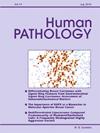cyld突变的肛门鳞状细胞癌:一种罕见的与柱状瘤样形态和不良临床特征相关的实体
IF 2.7
2区 医学
Q2 PATHOLOGY
引用次数: 0
摘要
肛门鳞状细胞癌(SqCC)可大致分为hpv阳性组和hpv阴性组,每组都有不同的临床病理特征和结局。cyld突变肛门SqCC最近被认为与柱状瘤样组织学特征、HPV阳性、罕见的PIK3CA突变和低肿瘤突变负担密切相关。在这种情况下,CYLD突变对预后的影响尚未确定。我们对109例临床病理特征良好的肛门SqCC进行了CYLD突变分析,其中包括98例hpv阳性和11例hpv阴性癌。CYLD突变3例(占总数的2.8%,占hpv阳性病例的3.1%),均为hpv16阳性。CYLD突变与更频繁的柱状基底膜包涵体(p = 0.0002)和基底样细胞形态(p = 0.017)显著相关。只有4%的cyld野生型癌表现出柱状瘤样特征,相对于cyld突变病例,其程度有限。在hpv阳性组中,CYLD突变和柱状瘤样形态与更高的转移性疾病进展率相关(分别为p = 0.022和p = 0.01), 3例CYLD突变患者中有2例在初次诊断后6个月和7个月发生肝转移。cyld突变病例均无其他突变,包括PIK3CA和TP53突变。我们的研究结果进一步证实,cyld突变的肛门SqCC是一种罕见但独特的临床病理实体,具有独特的病理特征,并可能与不良临床结果相关。在hpv阳性的肛门SqCC中,CYLD突变代表了这种独特实体的潜在有用的新标记,柱状瘤样形态可以作为识别此类病例的有用特征。本文章由计算机程序翻译,如有差异,请以英文原文为准。
CYLD-mutated anal squamous cell carcinoma: An uncommon entity associated with cylindroma-like morphology and adverse clinical features
Anal squamous cell carcinoma (SqCC) can be broadly divided into HPV-positive and HPV-negative groups, each with distinct clinicopathologic features and outcome. CYLD-mutant anal SqCC was recently characterized as having a strong association with cylindroma-like histologic features, HPV positivity, infrequent PIK3CA mutation, and low tumor mutational burden. The prognostic impact of CYLD mutation in this context has not been established. We performed CYLD mutational analysis on a cohort of 109 clinicopathologically well-characterized cases of anal SqCC including 98 HPV-positive and 11 HPV-negative carcinomas. CYLD mutation was present in 3 cases (2.8 % of total, 3.1 % of HPV-positive cases), all of which were HPV16-positive. CYLD mutation was significantly associated with more frequent cylindroma-like basement membrane inclusions (p = 0.0002) and basaloid cytomorphology (p = 0.017). Just 4 % of CYLD-wildtype carcinomas demonstrated cylindroma-like features, which were limited in extent relative to CYLD-mutant cases. Among the HPV-positive group, CYLD mutation and cylindroma-like morphology were associated with a higher rate of metastatic disease progression (p = 0.022 and p = 0.01, respectively), with 2 of 3 CYLD-mutant patients developing liver metastasis at 6 and 7 months after initial diagnosis. None of the CYLD-mutant cases had other mutations including PIK3CA and TP53 mutations. Our findings further establish CYLD-mutant anal SqCC as an infrequent but distinct clinicopathologic entity with characteristic pathogenetic features and a possible association with adverse clinical outcomes. Among HPV-positive anal SqCC, CYLD mutation represents a potentially useful novel marker for this distinct entity and cylindroma-like morphology serves as a useful feature to identify such cases.
求助全文
通过发布文献求助,成功后即可免费获取论文全文。
去求助
来源期刊

Human pathology
医学-病理学
CiteScore
5.30
自引率
6.10%
发文量
206
审稿时长
21 days
期刊介绍:
Human Pathology is designed to bring information of clinicopathologic significance to human disease to the laboratory and clinical physician. It presents information drawn from morphologic and clinical laboratory studies with direct relevance to the understanding of human diseases. Papers published concern morphologic and clinicopathologic observations, reviews of diseases, analyses of problems in pathology, significant collections of case material and advances in concepts or techniques of value in the analysis and diagnosis of disease. Theoretical and experimental pathology and molecular biology pertinent to human disease are included. This critical journal is well illustrated with exceptional reproductions of photomicrographs and microscopic anatomy.
 求助内容:
求助内容: 应助结果提醒方式:
应助结果提醒方式:


